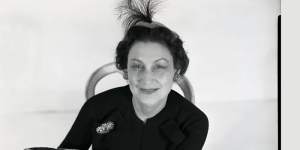
Christian Dior with his “first assistant designer” Mizza Bricard.Supplied
Yes,Google assures us,he did. Her name was Mizza Bricard,and the search results fill in other tantalising details:she never wore knickers (because muses are always scantily clad),she was ademimondaine,which is an elegantly French way of saying sex worker,and she once performed in a nude revue. Of course she did! Muses and clothes go together like Chanel and Schiaparelli – never to be seen in the same room.
Perhaps it’s Mizza’s fault – she let herself be photographed by Louise Dahl-Wolfe while dressed in a fur coat pulled down to reveal what could be a hint of areola. And she’s leaning forward,the way only a temptress would. Pair that image with the anecdotes above and it’s easy to believe that all Mizza did was use her green eyes,cleavage and salacious past to inspire Christian Dior to make the kind of dresses that mean his name is still known by people some 70 years on,whereas hers has been conquered by history.
It’s a familiar tale. Dora Maar was Picasso’s lover and inspiration. Camille Claudel stirred Rodin to brilliance. Loulou de la Falaise became Yves Saint Laurent’s living mannequin. But didn’t Maar paint? Wasn’t Claudel a sculptor? And I’m sure de la Falaise designed some spectacular jewellery. So why isn’t their art the first thing you see when you search their names? Why does the word muse always come a long way before their genius?
The same thing has happened to Mizza Bricard. There’s another version of her out there,one that bears little resemblance to the woman patronised and demeaned in every article written about her over the past 40-odd years.

She was extraordinarily talented,but Mizza Bricard remains largely unrecognised.Supplied
In this alternative and almost unreported version,fashion writer Elene Foster says,in a newspaper profile from 1950:“She[Mizza] is a most important person on the Dior staff,second only to the great man himself … she is first assistant designer to Christian Dior.”
First assistant designer? Second only to the great man himself? No mention of the word muse? Perhaps Foster made a mistake? But no. If you trace back through the archival records,you’ll find this story …
Mizza Bricard began life as Germaine Louise Neustadt. She was later known as Madame Biano,Madame B.,Madame Biano-Bricard and Mitzah Bricard. If you know the names a person used,you can find out things about them. And I did.
Throughout the late 1920s and into the 1930s,Madame Biano was the head designer for Mirande,a French fashion label created by the House of Doucet,one of the largest fashion conglomerates of the early 20th century. Her opinions were so well regarded that she was commissioned to write columns for American newspapers about the latest fashion trends. And she also created fashion trends.
In 1934,Vogue reported that Madame Biano wore a littletoupet – a detachable accessory made from her own curls – to an evening salon,the perfect solution for anyone wanting to experiment with a commitment-free fringe. After that,the fringe-as-accessory was seen everywhere for a season or two. She designed for royalty;the queen of Spain purchased clothes created by Mizza. Before working for Dior,she was assistant designer at Molyneux. After he fled the Nazis,none other than the great Cristobàl Balenciaga gave her an entire millinery studio to run.
Was it simply because she was a woman and,in the business of making art,women are only ever the spark,never the crowd-stopping fireworks display?
The traces of this extraordinary,creative,glass-ceiling-smashing life can be discovered in letters that languish in archives in Europe and America. For example,the papers of renowned fashion photographer Cecil Beaton state:“There are in the world of fashion those whose names have become almost household words merely through the good offices of their personal relations officer. There are others who remain unsung,yet who are held in the highest respect by the brightest talents:Mizza Bricard is such a one … The greatest dressmakers know her worth.” And in Mizza’s obituary,by Englishwoman Lady Jane Abdy:“Many considered her to be a greater designer than Coco Chanel.”
A greater designer than the legendary Coco Chanel? How did a woman who influenced and designed for arguably two of the greatest talents in fashion – Balenciaga and Dior – become a knickerless whore whose sole claim to fame was gifting Christian Dior the inspiration to design gowns that changed the fashion world forever? Why are women always and forever only the inspiration in the creative process,rather than the actual creator?
Was it because Mizza was beautiful? Was it because she was so incredibly talented,yet never hung an awning bearing her own name outside a Paris boutique? Was it because she had one of the most astonishing jewellery collections in Paris,a collection largely furnished by her friend and Cartier jewellery designer Jeanne Toussaint (Jeanne recognised a great influencer before the word had been invented) but rumoured by later authors to have been gifted to her by the Aga Khan and a Turkish prince. After all,how would a woman come by a seven-stranded pearl necklace without granting certain favours for it?
Or was it simply because she was a woman and in,the business of making art,women are only ever the spark,never the crowd-stopping fireworks display,the blank canvas but never the masterpiece? What would so-called Klimt muse Emilie de Flöge – also a talented fashion designer – say if she could see how history has decided to remember her? What would Maar and de la Falaise and Claudel say? And when will there come a time when a woman working alongside a man is granted equal respect,rather than the pejorative title of “muse”?
In the absence of an answer to that question,I’ll leave you with a description of Mizza from Parisian mannequin Praline,who says in her 1951 memoir:“Dior est protégé de Dieu. Des déesses aussi. C’en est une que cette exquise Madame Bricard,au teint pâle et yeux verts,femme du monde s’il en est …” Roughly translated,this means,“Dior is protected by God. Goddesses too. One such is the exquisite Madame Bricard,with a pale complexion and green eyes,a woman of the world if there ever was one …”
Revered and a goddess. I don’t think anyone has to look too far to think of a woman who’s been remoulded by the media,by gossip,and by spite into something less than she actually was. It’s been happening for centuries,and it happens still. I hope women in 100 years time aren’t still writing articles like this one,that Mizza and her fellow creators will one day be granted the accolades and the recognition that they deserve.
(Hachette) by Natasha Lester is out now.
Make the most of your health,relationships,fitness and nutrition with our Live Well newsletter. every Monday.